Disturbance Elimination for Partial Discharge Detection in the Spacer of Gas-Insulated Switchgears
Abstract
:1. Introduction
2. Insulation Defects in Spacer
3. Experimental Setup
4. Wavelet Transform
4.1. Selection of Mother Wavelet
4.2. The Determination of Decomposition Level
4.3. Decomposition of PRPD and Signal Energy
4.4. Threshold and Thresholding Function
4.5. Signal Reconstruction
5. Results and Discussions
5.1. Simulated PRPD
5.2. PRPD in the POS and the Crack
6. Conclusions
Author Contributions
Conflicts of Interest
References
- Bartnikas, R. Partial discharges their mechanism, detection and measurement. IEEE Trans. Dielectr. Electr. Insul. 2002, 9, 763–808. [Google Scholar] [CrossRef]
- Liu, M.; Tang, J.; Yao, Q.; Miao, Y. Study on the characteristic decomposition components of DC SF6-insulated equipment under positive DC partial discharge. Energies 2017, 10, 640. [Google Scholar] [CrossRef]
- Tang, J.; Yang, X.; Yang, D.; Yao, Q.; Miao, Y.; Zhang, C.; Zeng, F. Using SF6 decomposed component analysis for the diagnosis of partial discharge severity initialted by free metal particle defect. Energies 2017, 10, 1119. [Google Scholar] [CrossRef]
- Zhu, M.X.; Zhang, J.N.; Li, Y.; Wei, Y.H.; Xue, J.Y.; Deng, J.B.; Mu, H.B.; Zhang, G.J.; Shao, X.J. Partial discharge signals separation using cummulative energy function and mathematical morphology gradient. IEEE Trans. Dielectr. Electr. Insul. 2015, 23, 482–493. [Google Scholar] [CrossRef]
- Neumann, C.; Rusek, B.; Balzer, G.; Jeromin, I. End of Life Estimation and Optimisation of Maintenance of HV Switchgear and GIS Substations; A3 202; CIGRE: Paris, France, 2012; pp. 1–12. [Google Scholar]
- CIGRE Working Groups. Long-Term Performance of SF6 Insulated Systems; CIGRE: Paris, France, 2002. [Google Scholar]
- Ueta, G.; Wada, J.; Okabe, S.; Miyashita, M.; Nishida, C.; Kamei, M. Insulation performance of three types of micro-defects in inner epoxy insulators. IEEE Trans. Dielectr. Electr. Insul. 2012, 19, 947–954. [Google Scholar] [CrossRef]
- Braun, J.M.; Ford, G.L.; Fujimoto, N.; Rizzetto, S.; Stone, G.C. Reliability of GIS EHV epoxy insulators: The need and prospects for more stringent acceptance criteria. IEEE Trans. Power Deliv. 1993, 8, 121–131. [Google Scholar] [CrossRef]
- International Electrotechnical Commission. High-Voltage Switchgear and Controlgear-Part 203: Gas-Insulated Metal-Enclosed Switchgear for Rated Voltages above 52 Kv; IEC 62271-203; IEC: Geneva, Switzerland, 2003. [Google Scholar]
- Yang, L.; Judd, M.D.; Bennoch, C.J. Denoising UHF signal for PD detection in transformers based on wavelet technique. In Proceedings of the 2004 Annual Report Conference on Electrical Insulation and Dielectric Phenomena, Boulder, CO, USA, 20 October 2004. [Google Scholar]
- Satish, L.; Nazneen, B. Wavelet-based denoising of partial discharge signals buried in excessive noise and interference. IEEE Trans. Dielectr. Electr. Insul. 2003, 10, 354–367. [Google Scholar] [CrossRef]
- Ma, X.; Zhou, C.; Kemp, I.J. Automated wavelet selection and thresholding for PD detection. IEEE Electr. Insul. Mag. 2002, 18, 37–45. [Google Scholar] [CrossRef]
- Zhou, X.; Zhou, C.; Kemp, I.J. An improved methodology for application of wavelet transform to partial discharge measurement denoising. IEEE Trans. Dielectr. Electr. Insul. 2015, 12, 586–594. [Google Scholar] [CrossRef]
- Zhang, H.; Blackburn, T.R.; Phung, B.T.; Sen, D. A novel wavelet transform technique for on-line partial discharge measurements part 1: WT de-nosing algorithm. IEEE Trans. Dielectr. Electr. Insul. 2007, 14, 3–14. [Google Scholar] [CrossRef]
- Zhang, H.; Blackburn, T.R.; Phung, B.T.; Sen, D. A novel wavelet transform technique for on-line partial discharge measurements part 2: On-site nois rejection application. IEEE Trans. Dielectr. Electr. Insul. 2007, 14, 15–22. [Google Scholar] [CrossRef]
- Chang, C.S.; Jin, J.; Chang, C.; Hoshino, T.; Hanai, M.; Kobayashi, N. Separation of corona using wavelet packet transform and neural network for detection of partial discharge in gas-insulated substations. IEEE Trans. Power Deliv. 2005, 20, 1363–1369. [Google Scholar] [CrossRef]
- Wu, M.; Cao, H.; Cao, J.; Nguyen, H.L.; Gomes, J.B.; Krishnaswamy, S.P. An overview of state-of-the-art partial discharge analysis techniques for condition monitoring. IEEE Electr. Insul. Mag. 2015, 31, 22–35. [Google Scholar] [CrossRef]
- Ma, H.; Chan, J.C.; Saha, T.K.; Ekanayake, C. Pattern recognition techniques and their applications for automatic classification of artificial partial discharge sources. IEEE Trans. Dielectr. Electr. Insul. 2013, 20, 468–478. [Google Scholar] [CrossRef]
- CIGRE Working Groups. Risk Assessment on Defects in GIS Based on PD Diagnosis; CIGRE: Paris, France, 2013. [Google Scholar]
- Mansour, D.A.; Kojima, H.; Hayakawa, N.; Endo, F.; Okubo, H. Partial discharges and associated mechanisms for micro gap delamination at epoxy spacer in GIS. IEEE Trans. Dielectr. Electr. Insul. 2010, 17, 855–861. [Google Scholar] [CrossRef]
- Ji, H.X.; Li, C.R.; Ma, G.M.; Pang, Z.K.; Tang, Z.G.; Wen, H.; Cui, B.Y. Partial discharge occurrence induced by crack defect on GIS insulator operated at 1100 kV. IEEE Trans. Dielectr. Electr. Insul. 2016, 23, 2250–2257. [Google Scholar] [CrossRef]
- Wang, G.M.; Jo, H.E.; Kim, S.J.; Kim, S.W.; Kil, G.S. Measurement and analysis of partial discharge in SF6 gas under HVDC. Measurement 2016, 91, 351–359. [Google Scholar] [CrossRef]
- Grgic, S.; Grgic, M.; Zovko-Cihlar, B. Performance analysis of image compression using wavelets. IEEE Trans. Ind. Electron. 2001, 48, 682–695. [Google Scholar] [CrossRef]
- Moula, B.; Mekhaldil, A.; Teguar, M.; Haddad, A. Characteristics of discharge on non-uniformly polluted glass surface using a wavelet transform approach. IEEE Trans. Dielectr. Electr. Insul. 2013, 20, 1457–1466. [Google Scholar] [CrossRef]
- Carvalho, A.T.; Lima, A.C.S.; Cunha, C.F.F.C.; Petraglia, M. Identification of partial discharge immersed in noise in large hydro-generators based on improved wavelet selection methods. Measurement 2015, 75, 122–133. [Google Scholar] [CrossRef]
- International Electrotechnical Commission. High-Voltage Test Techniques-Partial Discharge Measurements; IEC 60270; IEC: Geneva, Switzerland, 2000. [Google Scholar]
- Ma, X.; Zhou, C.; Kemp, I.J. Interpretation of wavelet analysis and its application in partial discharge detection. IEEE Trans. Dielectr. Electr. Insul. 2002, 9, 446–457. [Google Scholar] [CrossRef] [Green Version]
- Hsieh, M.S.; Tseng, D.C.; Huang, Y.H. Hiding digital watermarks using multiresolution wavelet transform. IEEE Trans. Ind. Electron. 2001, 48, 875–882. [Google Scholar] [CrossRef]
- Li, J.; Jiang, T.; Grzybowski, S.; Cheng, C. Scale dependent wavelet selection for de-noising of partial discharge detection. IEEE Trans. Dielectr. Electr. Insul. 2010, 17, 1705–1714. [Google Scholar] [CrossRef]
- Shim, I.; Soraghan, J.J.; Siew, W.H. Detection of PD utilizing digital singal processing method. Part 3: Open-loop noise reduction. IEEE Electr. Insul. Mag. 2001, 17, 6–13. [Google Scholar] [CrossRef]
- Wang, G.M.; Kim, S.J.; Kil, G.S.; Kim, S.W. Optimization of wavelet and thresholding for partial discharge detection under HVDC. IEEE Trans. Dielectr. Electr. Insul. 2017, 24, 200–208. [Google Scholar] [CrossRef]
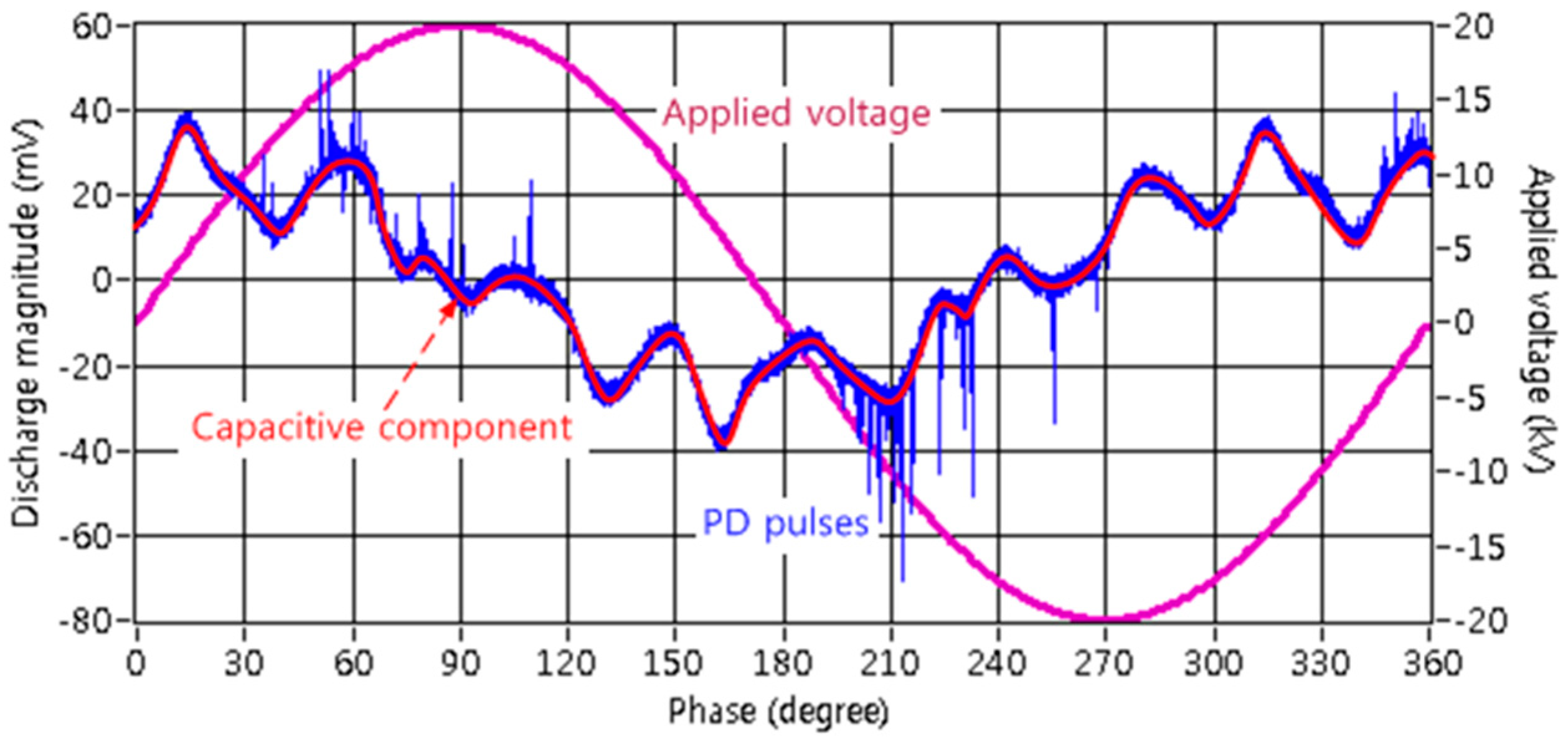
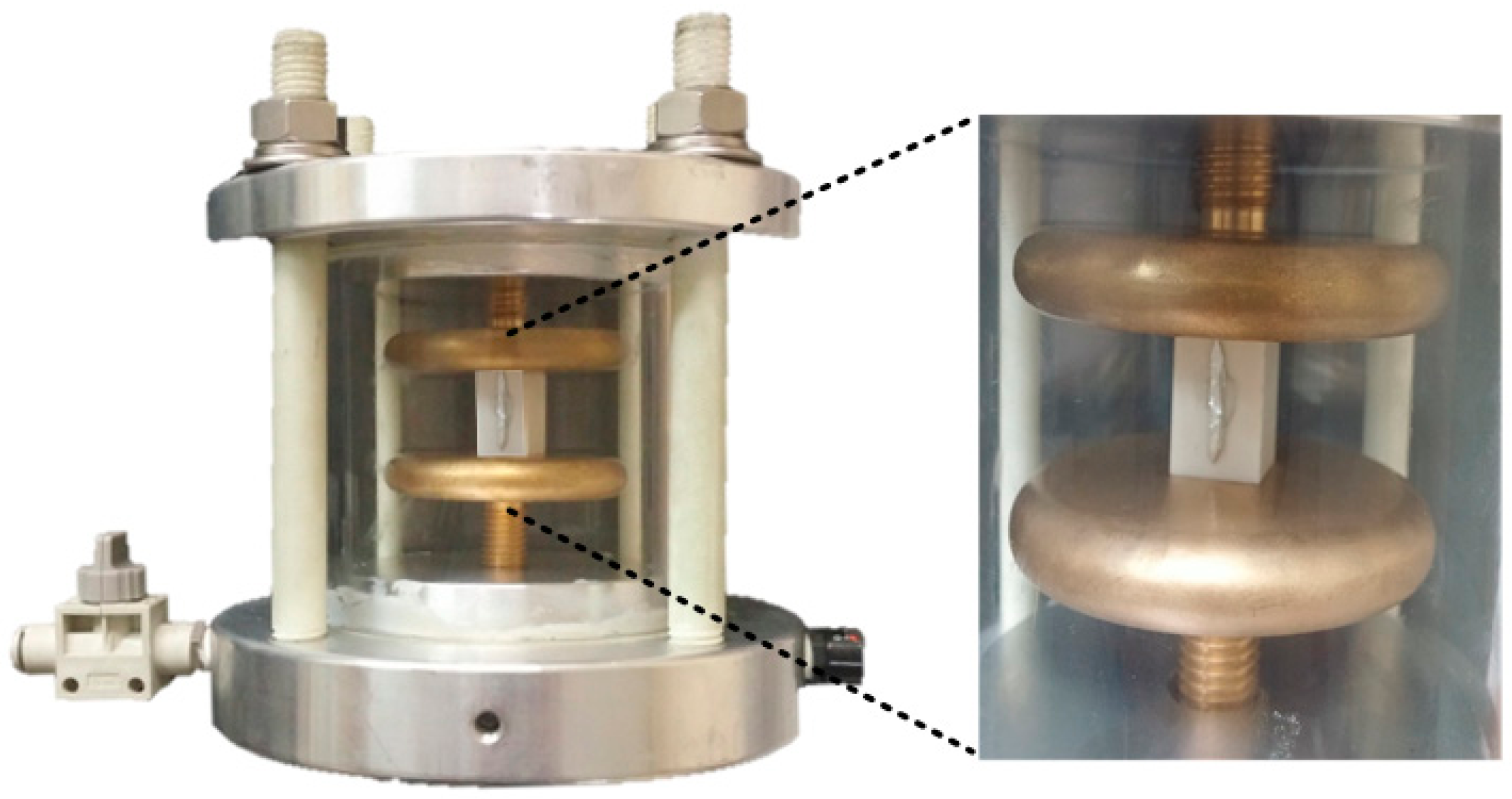

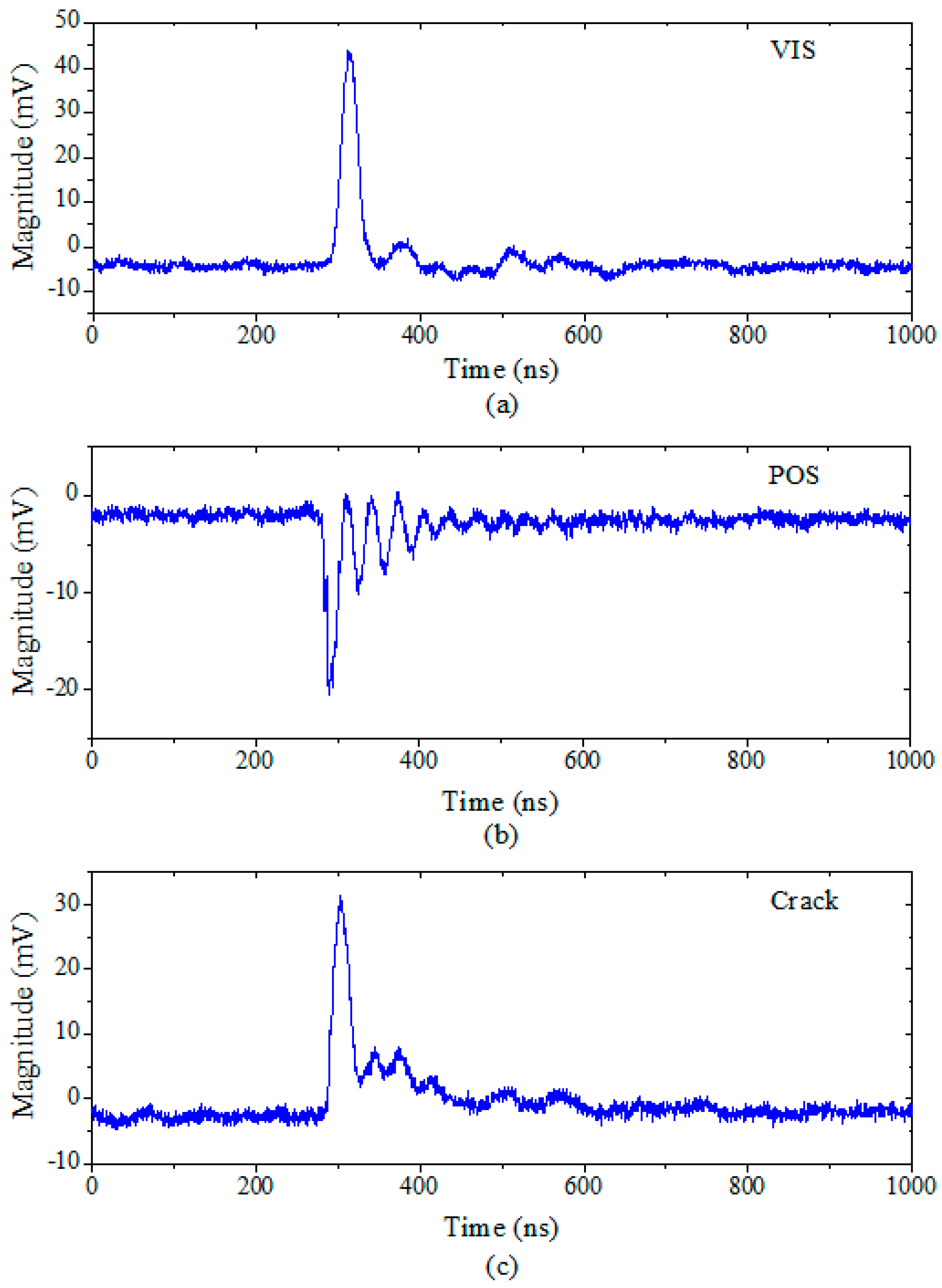
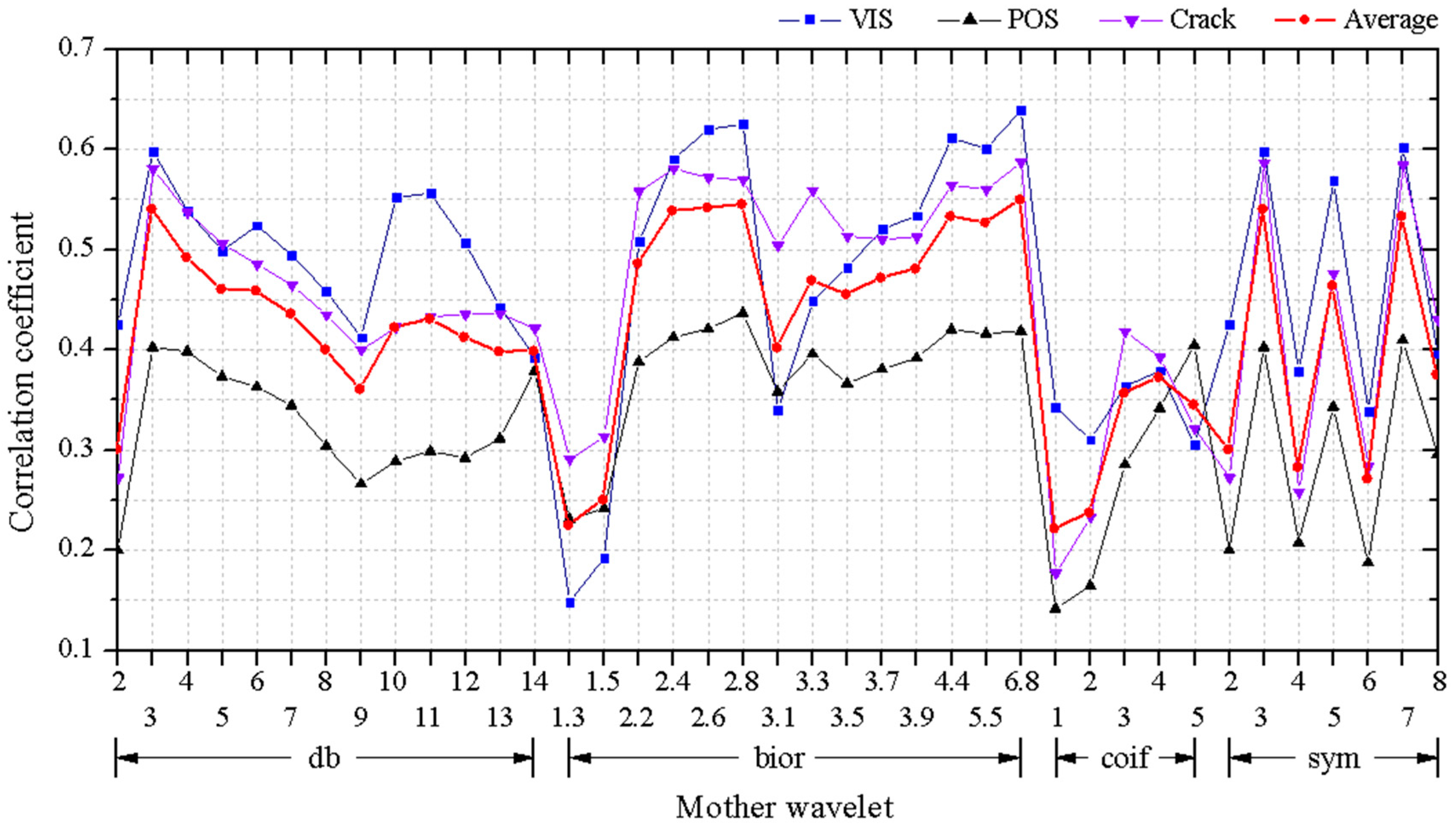

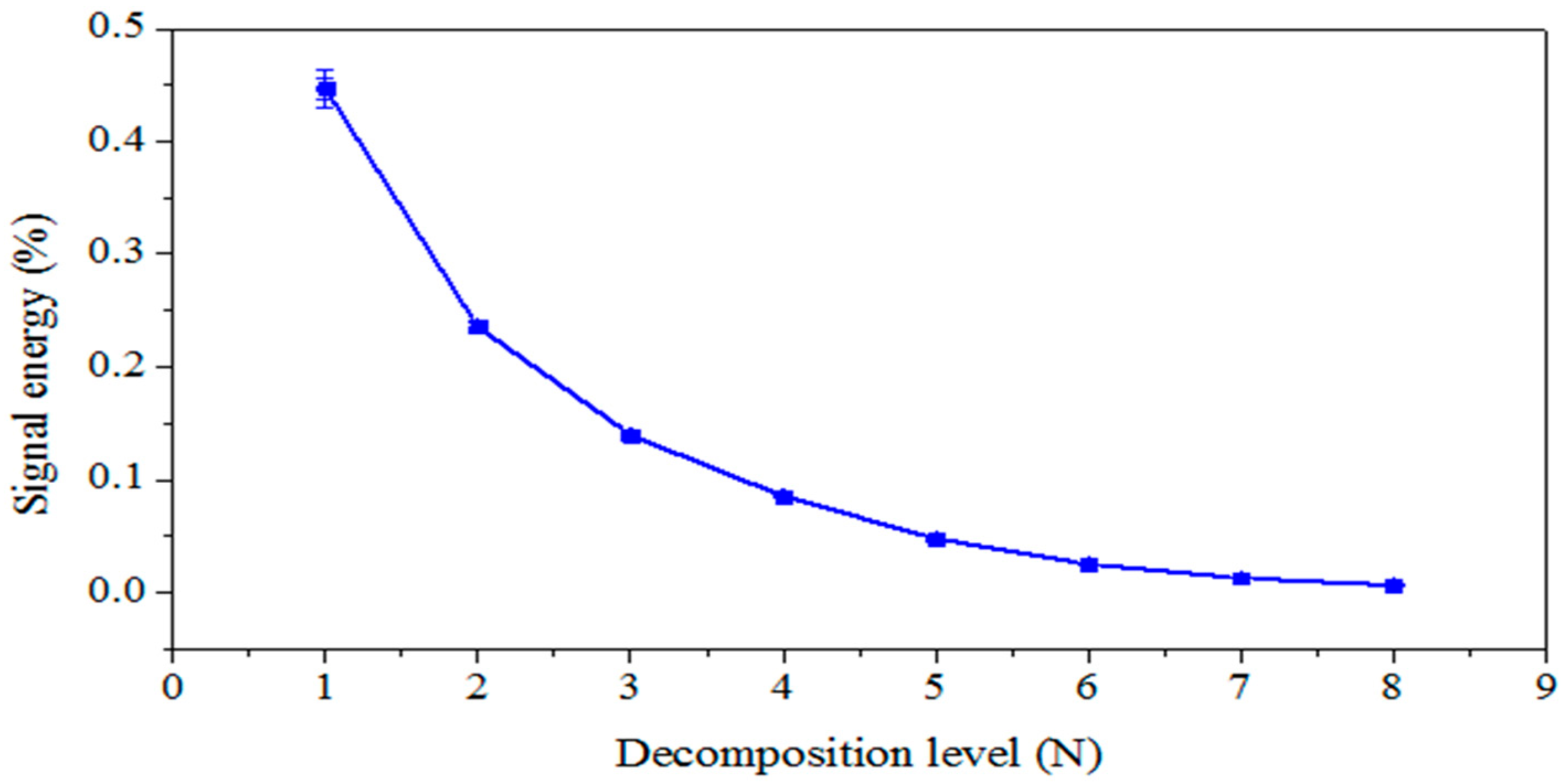


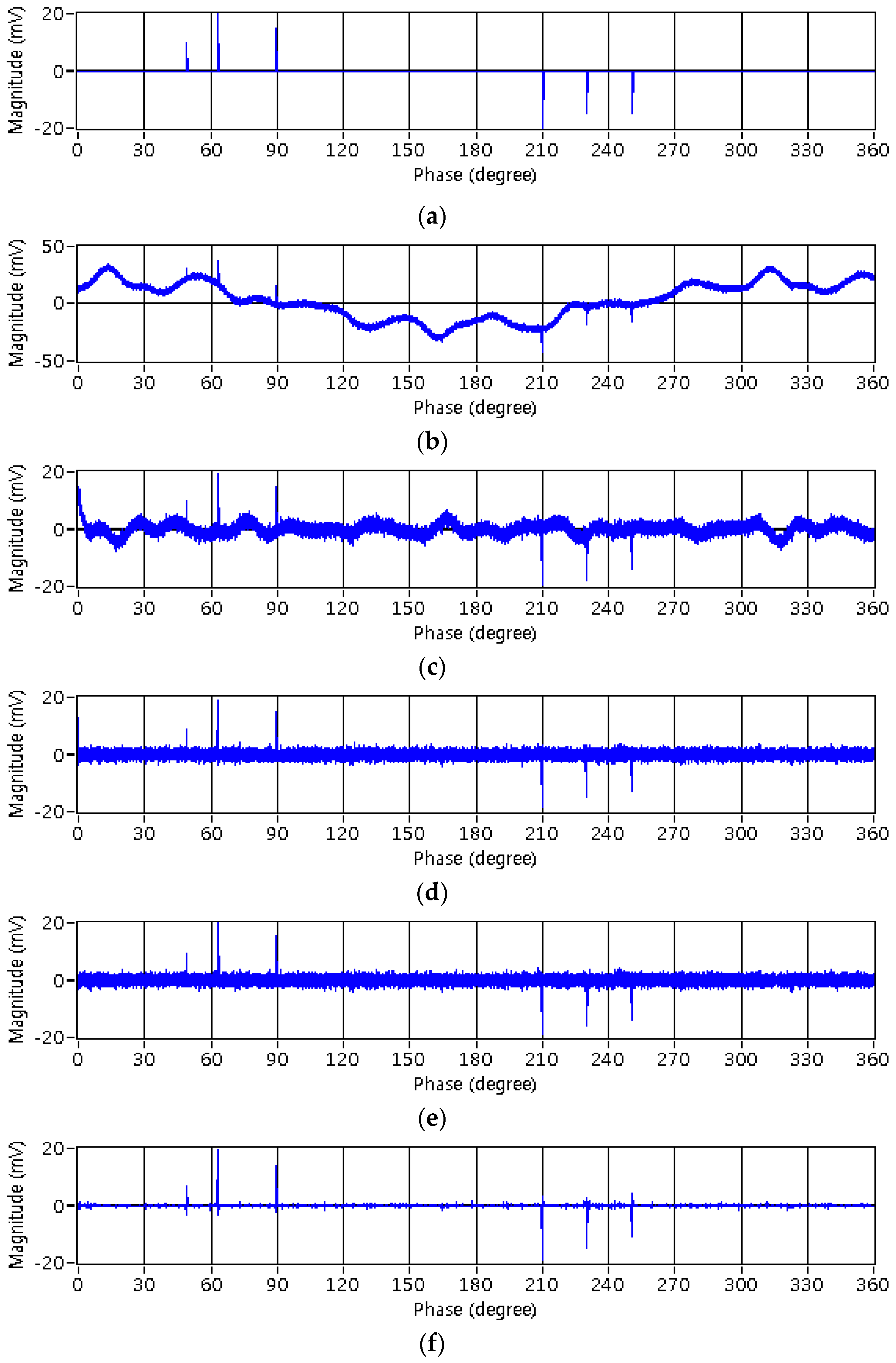

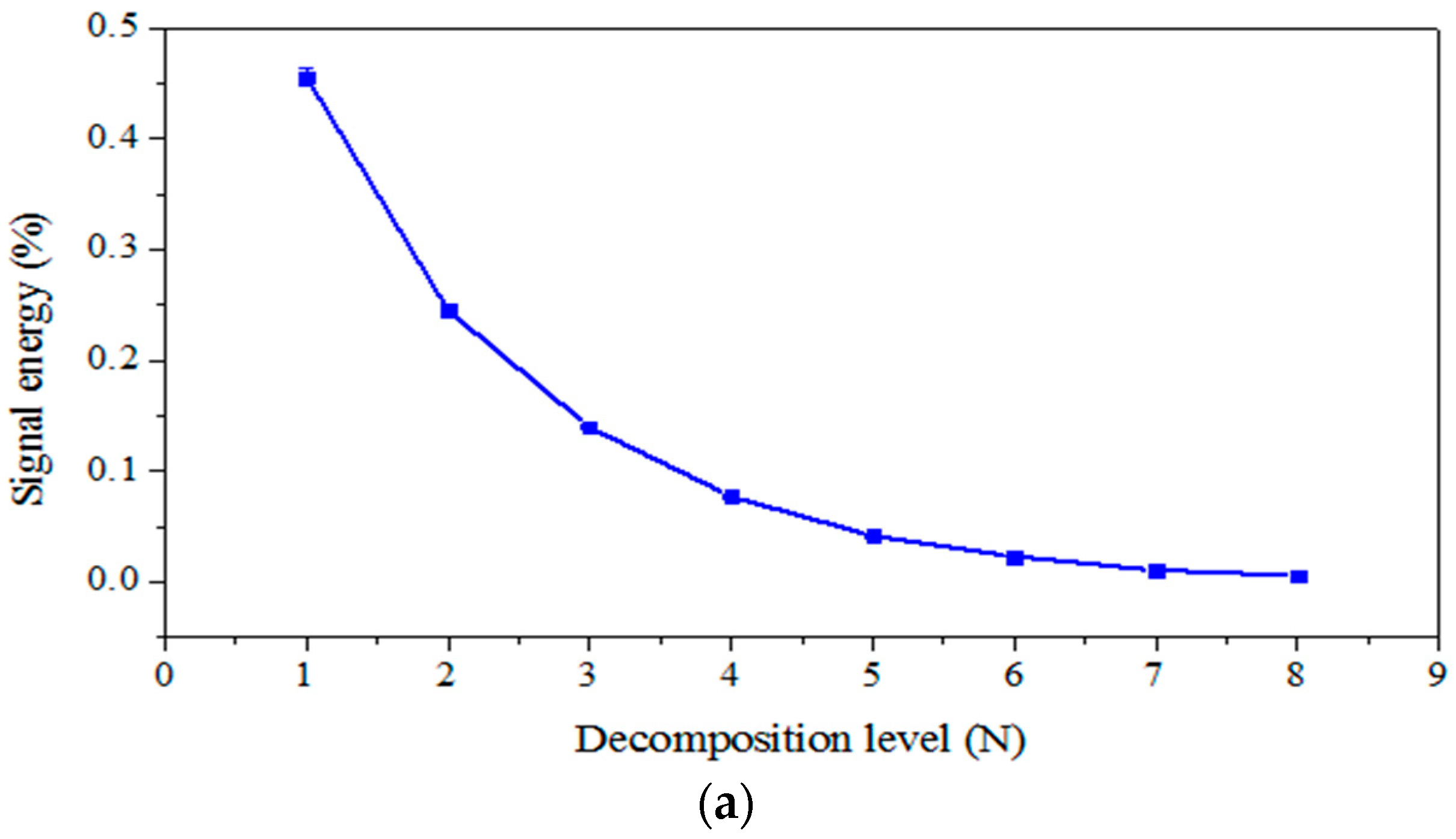
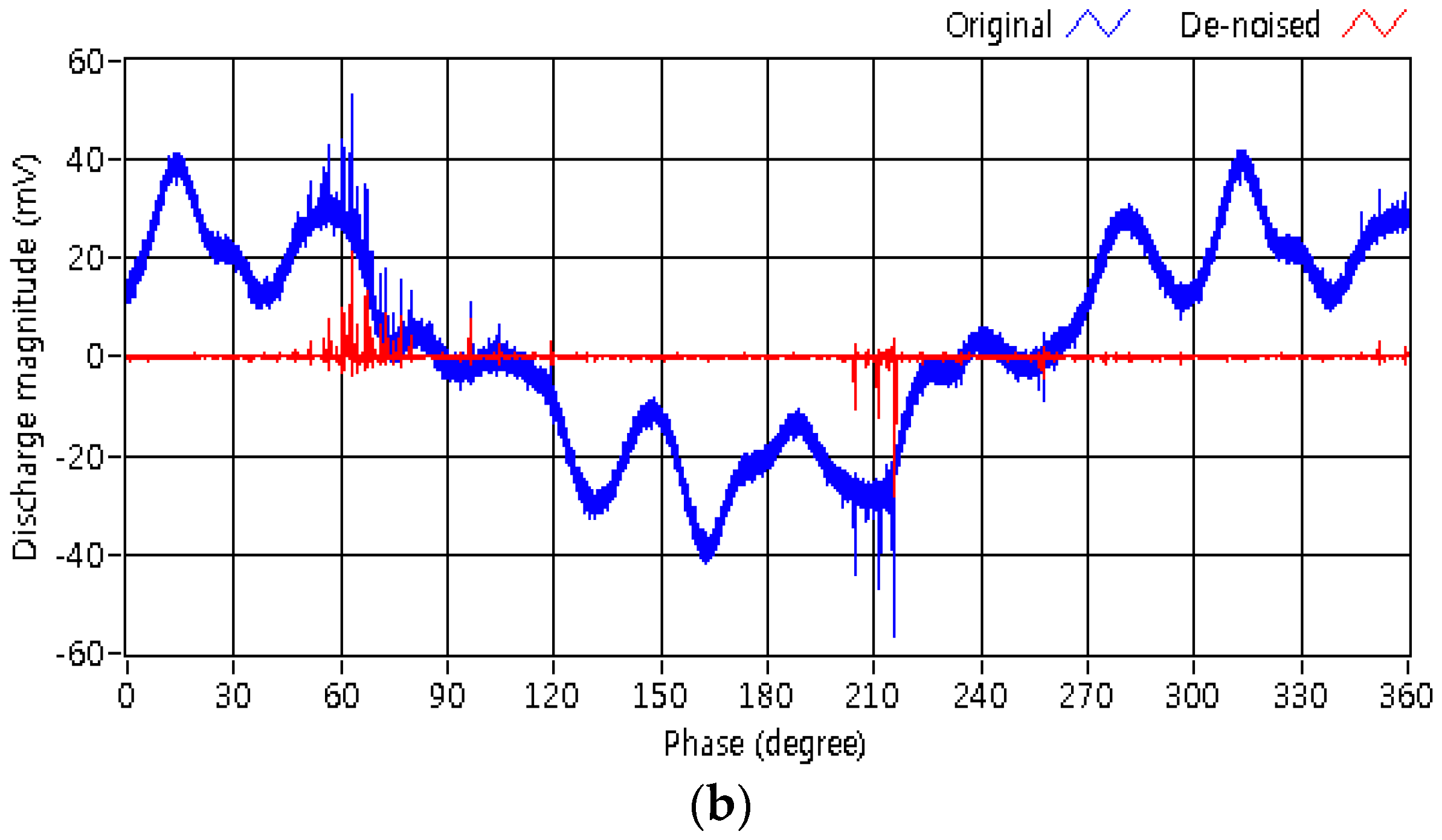
| Method | Correlation Coefficient | SNR | Reduction in Amplitude [%] |
|---|---|---|---|
| 1 kHz filter | 0.063 | −23.91 | 2.69 |
| 9 kHz filter | 0.135 | −17.35 | 3.02 |
| 100 kHz filter | 0.134 | −16.77 | 5.51 |
| Wavelet, noisy D1–D5 | 0.141 | −16.76 | 0.19 |
| Wavelet, de-noised D1–D5 | 0.814 | 4.17 | 2.30 |
| Wavelet, de-noised D1–D8 | 0.813 | 4.09 | 1.70 |
© 2017 by the authors. Licensee MDPI, Basel, Switzerland. This article is an open access article distributed under the terms and conditions of the Creative Commons Attribution (CC BY) license (http://creativecommons.org/licenses/by/4.0/).
Share and Cite
Wang, G.; Kil, G.-S.; Ji, H.-K.; Lee, J.-H. Disturbance Elimination for Partial Discharge Detection in the Spacer of Gas-Insulated Switchgears. Energies 2017, 10, 1762. https://doi.org/10.3390/en10111762
Wang G, Kil G-S, Ji H-K, Lee J-H. Disturbance Elimination for Partial Discharge Detection in the Spacer of Gas-Insulated Switchgears. Energies. 2017; 10(11):1762. https://doi.org/10.3390/en10111762
Chicago/Turabian StyleWang, Guoming, Gyung-Suk Kil, Hong-Keun Ji, and Jong-Hyuk Lee. 2017. "Disturbance Elimination for Partial Discharge Detection in the Spacer of Gas-Insulated Switchgears" Energies 10, no. 11: 1762. https://doi.org/10.3390/en10111762
APA StyleWang, G., Kil, G.-S., Ji, H.-K., & Lee, J.-H. (2017). Disturbance Elimination for Partial Discharge Detection in the Spacer of Gas-Insulated Switchgears. Energies, 10(11), 1762. https://doi.org/10.3390/en10111762





